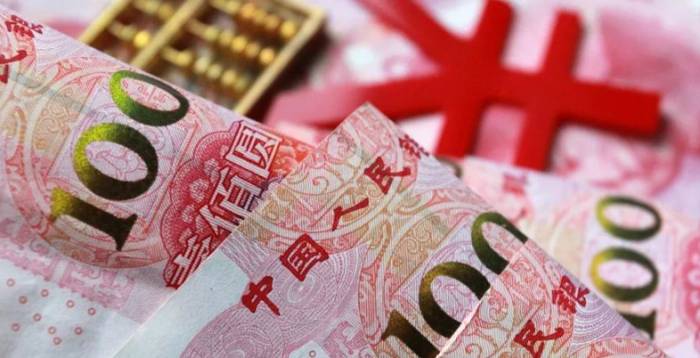As a series of policies to boost market confidence were introduced, the positive effects quickly transmitted to the exchange rate.
On September 24th Beijing time, the onshore and offshore Renminbi (RMB) spot exchange rates against the US dollar successively broke through the 7.06, 7.05, and 7.04 thresholds during the trading session. By 18:05 that day, the onshore RMB exchange rate against the US dollar had risen by 267 basis points from the previous trading day to 7.0320 yuan, reaching a new high in 16 months; the offshore RMB exchange rate against the US dollar had risen by 314 basis points from the previous trading day to 7.0307 yuan, once breaking through 7.03 during the session, for the first time since May 2023. On the same day, the RMB exchange rate against the US dollar midpoint was reported at 7.0510, with an increase of 21 basis points.
On September 24th, at a press conference held by the State Council Information Office, People's Bank of China (PBOC) Governor Pan Gongsheng announced that the PBOC would soon lower the reserve requirement ratio by 0.5 percentage points, providing approximately 1 trillion yuan in long-term liquidity to the financial market; depending on the state of market liquidity within the year, there may be a further reduction in the reserve requirement ratio by 0.25-0.5 percentage points. The central bank's policy interest rate, namely the 7-day reverse repo operation rate, was lowered by 0.2 percentage points, from the current 1.7% to 1.5%.
Advertisement
"Recently, the monetary policies of major economies have been adjusted, and the pressure on the RMB exchange rate to depreciate has been significantly eased and has turned to appreciation," Pan Gongsheng stated at the press conference, indicating that the recent adjustments in the monetary policies of major economies have significantly eased the depreciation pressure on the RMB exchange rate. The Federal Reserve's reduction of 50 basis points is the first rate cut after several years of the interest rate hiking cycle, and the monetary policies of major economies have entered a rate-cutting cycle, with the momentum for the US dollar to appreciate weakening. As the divergence between domestic and international monetary policy cycles converges, the external pressure on the basic stability of the RMB exchange rate has been significantly reduced.
The Federal Reserve's rate cut of 50 basis points last week has allayed market concerns about a US economic recession. The Goldman Sachs G10 foreign exchange team expects that the US dollar will experience a slight rebound in the next three months and then slow down again from a 6-month and 12-month perspective. Against the backdrop of the Federal Reserve's faster rate cuts, market concerns about a hard landing have diminished, and the overall outlook for risk appetite is optimistic.
Regarding the latest trend of the US dollar against the RMB, Goldman Sachs strategists believe it is more driven by a broad sell-off of the US dollar. "The recent appreciation of the RMB against the US dollar is mainly influenced by external factors, especially the market pricing changes following the Federal Reserve's rate cut and the US elections," the institution said.
ING strategists believe that the US dollar/RMB has actually fallen to a new low, reflecting both the overdue hedging of US dollar receivables by Chinese exporters and a re-rating of investment theories in China, as well as investors reducing their divestment positions in China.
For the US dollar itself, as investors turn to more cyclically aligned currencies and emerging market currencies, the reflationary environment is slightly unfavorable. ING expects that good stock market performance will drive a slight rise in the US dollar and maintain a soft landing, with the US Dollar Index continuing to fluctuate narrowly between 100.50 and 101.00.
The US dollar continued to fluctuate near its yearly low last week, closing lower but with limited losses. Moreover, with the US elections approaching in November, uncertainty is expected to rise significantly, and the market anticipates that it will be difficult for the US Dollar Index to fall further before the elections.Uncertainty regarding the external environment and the trend of the US dollar still persists. Pan Gongsheng stated that, from the perspective of China's domestic situation, the renminbi exchange rate still has a relatively stable and solid foundation. Firstly, from a macro level, the economic recovery and upward trend will further consolidate and strengthen. The strong monetary policy introduced by the People's Bank of China this time will help support the real economy, promote consumer spending by residents, and boost market confidence; secondly, the balance of payments remains fundamentally stable. The current account surplus to GDP ratio in the first half of the year was 1.1%, which should be considered a relatively reasonable range; thirdly, the People's Bank of China and the State Administration of Foreign Exchange attach great importance to the construction of the foreign exchange market. As the People's Bank of China has repeatedly clarified to the market, against the backdrop of the two-way floating of the renminbi exchange rate, participants should also view exchange rate fluctuations rationally, enhance the concept of risk neutrality, and avoid "betting on the direction of the exchange rate" or "betting on a one-way trend". Enterprises should focus on their main business, and financial institutions should adhere to serving the real economy well.

The People's Bank of China's position on exchange rate policy is clear and transparent. First, adhere to the market's decisive role in exchange rate formation and maintain exchange rate flexibility. Second, strengthen expectation guidance to prevent the foreign exchange market from forming a one-sided consensus expectation and self-fulfilling, guard against the risk of exchange rate over-adjustment, and maintain the basic stability of the renminbi exchange rate at a reasonable and balanced level.